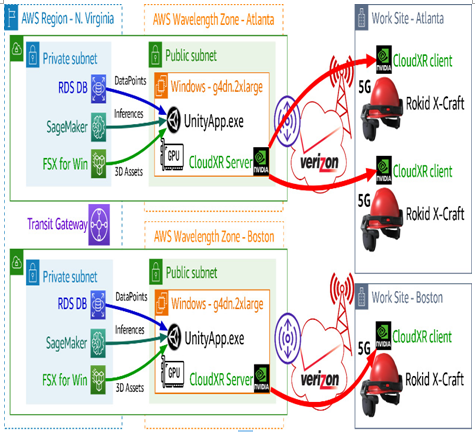Mobile edge computing (MEC) and connected workers – Addressing the Requirements of Immersive Experiences with AWS
Let’s zoom in on the specific use case of emergency response. There is no opportunity for first responders to ensure an appropriately designed Wi-Fi network is in place before responding to a call. Cellular connectivity is a must in such circumstances.
The Rokid X-Craft is an example of AR glasses that are appropriate for first responders. They can be attached to hardhats or fireman’s helmets, are waterproof (IP66), and even explosion-proof (Zone 1). Most importantly, they run an Android-based operating system locally that is capable of connecting via 5G directly without needing to be tethered to a mobile device.
The following figure illustrates an architecture for this specific scenario:

Figure 11.14 – Connected worker application using 5G-capable AR glasses
The glasses offload the heavy lifting of rendering to GPU-accelerated instances in AWS Wavelength Zone, which pixel streams to a lightweight client on the device. 5G supports the high throughput and low latency demands of many dozens of responders concentrated at the site of a disturbance or disaster.
Large databases run in the parent region(s) on Amazon Relational Database Service (RDS). The data points that are kept within them, such as the address of a particular building, combined with incoming data from a local utility can inform ML inferences in AWS SageMaker. These might tell the responder something like “The utility is reporting a gas leak down the street and there is an x% probability it has spread to this location by now.”
The library of 3D artifacts for systems like this is typically quite large, so they are kept in-region as well. Amazon FSX for Windows is a managed service that can expose this digital library over SMB 3, the preferred protocol in this case given that the streaming servers in AWS Wavelength are running Windows Server.
Finally, an AWS transit gateway connects the VPCs to provide a path for live communication between responders in cities whose parent Availability Zone is different from theirs.